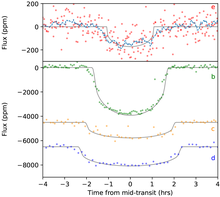K2-32

| K2-32 | ||
|---|---|---|
| 星座 | へびつかい座[1] | |
| 見かけの等級 (mv) | 12.31±0.02[2] | |
| 分類 | 恒星 | |
| 位置 | ||
| 赤経 (RA, α) | 16h 49m 42.2602s[3] | |
| 赤緯 (Dec, δ) | −19° 32′ 34.151″[3] | |
| 視線速度 (Rv) | −1.82±0.14 km/s[4] | |
| 固有運動 (μ) | 赤経: −16.662(18) ミリ秒/年[3] 赤緯: −53.564(13) ミリ秒/年[3] | |
| 年周視差 (π) | 6.3939 ± 0.0153ミリ秒[3] (誤差0.2%) | |
| 距離 | 510 ± 1 光年[注 1] (156.4 ± 0.4 パーセク[注 1]) | |
| 軌道要素と性質 | ||
| 惑星の数 | 4 | |
| 物理的性質 | ||
| 半径 | 0.845+0.044 −0.035 R☉[2] | |
| 質量 | 0.856±0.028 M☉[2] | |
| 表面重力 | 4.49±0.05 cgs[2] | |
| 自転速度 | 0.7 km/s[2] | |
| スペクトル分類 | G9V[5] | |
| 表面温度 | 5275±60 K[2] | |
| 金属量[Fe/H] | −0.02±0.04[2] | |
| 年齢 | 79±45 億年[2] | |
| 他のカタログでの名称 | ||
| 2MASS J16494226-1932340[6] | ||
| ■Template (■ノート ■解説) ■Project | ||
K2-32とは、太陽よりわずかに小さく、質量が小さいスペクトル分類がG9型の主系列星である[5]。4つの確認されたトランジットを起こす太陽系外惑星がK2-32の周囲を公転していることが知られている[7]。高エネルギーのK2-32からの照射によって引き起こされた惑星K2-32bからの大気散逸の研究は、K2-32が常に非常に遅く自転していたことを示している[8]。
惑星系[編集]


発見[編集]
K2-32は、2016年にAndrew Vanderburgと共同研究者によって3つのトランジットを起こす惑星候補を持っていることが最初に発見された[4]。当時、最も内側を公転している惑星候補であった惑星bは、W・M・ケック天文台で行われたドップラー分光法を用いたフォローアップ観測でその存在が確認された[5]。惑星cとdはSinukoffらによって確認された。補償光学イメージングやコンピュータ解析を使用して、誤検知の可能性は排除された[9]。
地球サイズの惑星eは、2019年にRené Hellerらのチームによって発見及び確認された[7][10]。
特徴[編集]
これらの4つの惑星の公転周期は主星に近いものからそれぞれ4.34、8.99、20.66、31.71日で、1:2:5:7の軌道共鳴の関係に非常に近い。惑星b・c・dの密度は土星と海王星の密度の間にあり、大規模な大気の存在を示唆している。地球の半径とほぼ同じ半径を持つ惑星eは、ほぼ確実に地球型惑星であるとされる[7]。4つの惑星はすべて、0.58天文単位に位置するハビタブルゾーンの楽観的な内側の境界からでさえも内側に位置している[11]。
| 名称 (恒星に近い順) | 質量 | 軌道長半径 (天文単位) | 公転周期 (日) | 軌道離心率 | 軌道傾斜角 | 半径 |
|---|---|---|---|---|---|---|
| e | 2.1+1.3 −1.1 M⊕ | 0.04899+0.00041 −0.00038 | 4.34934±0.00039 | 0.043+0.048 −0.030 | 89.0±0.7° | 1.212+0.052 −0.046 R⊕ |
| b | 15.0+1.8 −1.7 M⊕ | 0.07950+0.00066 −0.00062 | 8.992±0.00008 | 0.03+0.032 −0.02 | 89.0+0.5 −0.3° | 5.299±0.191 R⊕ |
| c | 8.1±2.4 M⊕ | 0.13843+0.00115 −0.00108 | 20.66093+0.00080 −0.00079 | 0.049+0.046 −0.035 | 89.4+0.3 −0.2° | 2.134+0.123 −0.102 R⊕ |
| d | 6.7±2.5 M⊕ | 0.18422+0.00152 −0.00144 | 31.71701+0.00101 −0.00096 | 0.05+0.053 −0.035 | 89.4±0.1° | 3.484+0.112 −0.129 R⊕ |
脚注[編集]
注釈[編集]
出典[編集]
- ^ Roman, Nancy G. (1987). “Identification of a Constellation From a Position”. Publications of the Astronomical Society of the Pacific 99 (617): 695–699. Bibcode: 1987PASP...99..695R. doi:10.1086/132034. Vizier query form
- ^ a b c d e f g h i Petigura, Erik A. et al. (2017). “Four Sub-Saturns with Dissimilar Densities: Windows into Planetary Cores and Envelopes”. The Astronomical Journal 153 (4): 142. arXiv:1702.00013. Bibcode: 2017AJ....153..142P. doi:10.3847/1538-3881/aa5ea5.
- ^ a b c d e Brown, A. G. A. (2021). “Gaia Early Data Release 3: Summary of the contents and survey properties”. アストロノミー・アンド・アストロフィジックス 649: A1. arXiv:2012.01533. Bibcode: 2021A&A...649A...1G. doi:10.1051/0004-6361/202039657.
- ^ a b Vanderburg, Andrew et al. (2016). “Planetary Candidates from the First Year of the K2 Mission”. The Astrophysical Journal Supplement Series 222 (1): 14. arXiv:1511.07820. Bibcode: 2016ApJS..222...14V. doi:10.3847/0067-0049/222/1/14.
- ^ a b c Dai, Fei et al. (2016). “Doppler Monitoring of Five K2 Transiting Planetary Systems”. The Astrophysical Journal 823 (2): 115. arXiv:1604.01413. Bibcode: 2016ApJ...823..115D. doi:10.3847/0004-637X/823/2/115.
- ^ "K2-32". SIMBAD. Centre de données astronomiques de Strasbourg. 2019年9月1日閲覧。
- ^ a b c d e f Heller, René; Rodenbeck, Kai; Hippke, Michael (2019). “Transit least-squares survey. I. Discovery and validation of an Earth-sized planet in the four-planet system K2-32 near the 1:2:5:7 resonance”. Astronomy and Astrophysics 625: A31. arXiv:1904.00651. Bibcode: 2019A&A...625A..31H. doi:10.1051/0004-6361/201935276.
- ^ Kubyshkina, D. et al. (2019). “Close-in Sub-Neptunes Reveal the Past Rotation History of Their Host Stars: Atmospheric Evolution of Planets in the HD 3167 and K2-32 Planetary Systems”. The Astrophysical Journal 879 (1): 26. arXiv:1906.12153. Bibcode: 2019ApJ...879...26K. doi:10.3847/1538-4357/ab1e42.
- ^ Sinukoff, Evan et al. (2016). “Eleven Multiplanet Systems From K2 Campaigns 1 and 2 and the Masses of Two Hot Super-Earths”. The Astrophysical Journal 827 (1): 78. arXiv:1511.09213. Bibcode: 2016ApJ...827...78S. doi:10.3847/0004-637X/827/1/78.
- ^ "Astronomers Discover 18 New Small Exoplanets in Kepler Data" (Press release). Sci-News.com. 28 May 2019. 2019年9月27日閲覧。
- ^ Wittenmyer, Robert A. et al. (2018). “The K2-HERMES Survey. I. Planet-candidate Properties from K2 Campaigns 1–3”. The Astronomical Journal 155 (2): 84. arXiv:1712.06774. Bibcode: 2018AJ....155...84W. doi:10.3847/1538-3881/aaa3e4.
- ^ Lillo-Box, J. et al. (2020). “Masses for the seven planets in K2-32 and K2-233”. Astronomy & Astrophysics 640: A48. arXiv:2006.01102. Bibcode: 2020A&A...640A..48L. doi:10.1051/0004-6361/202037896.